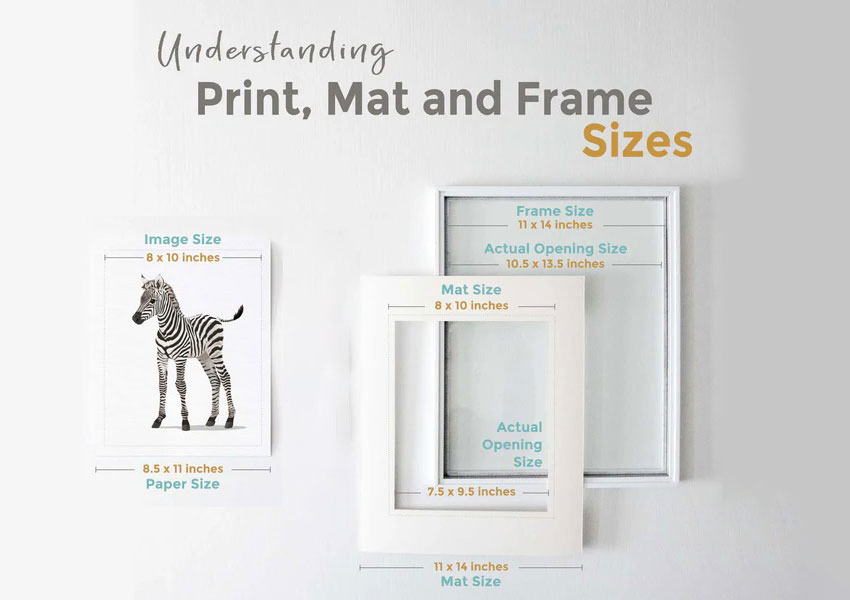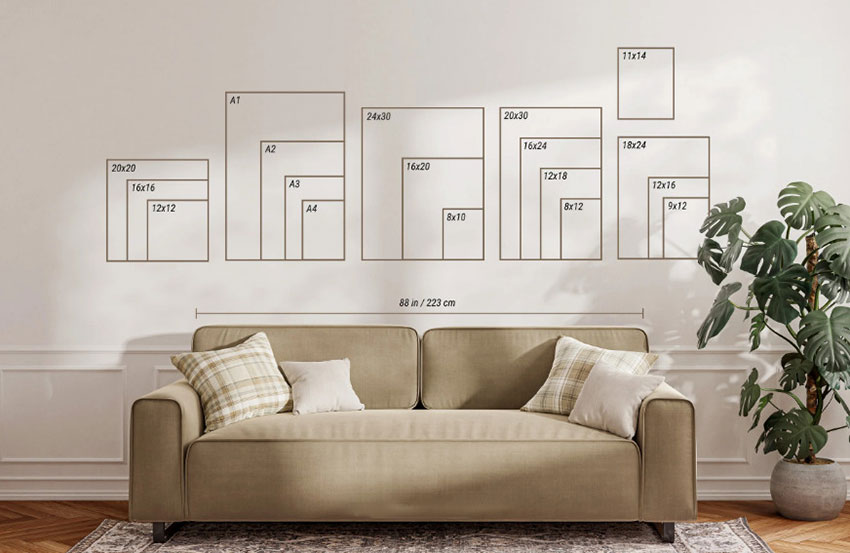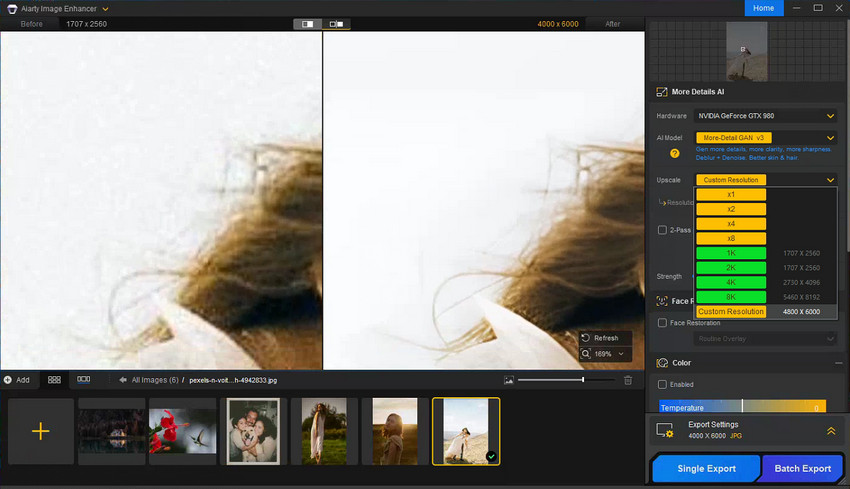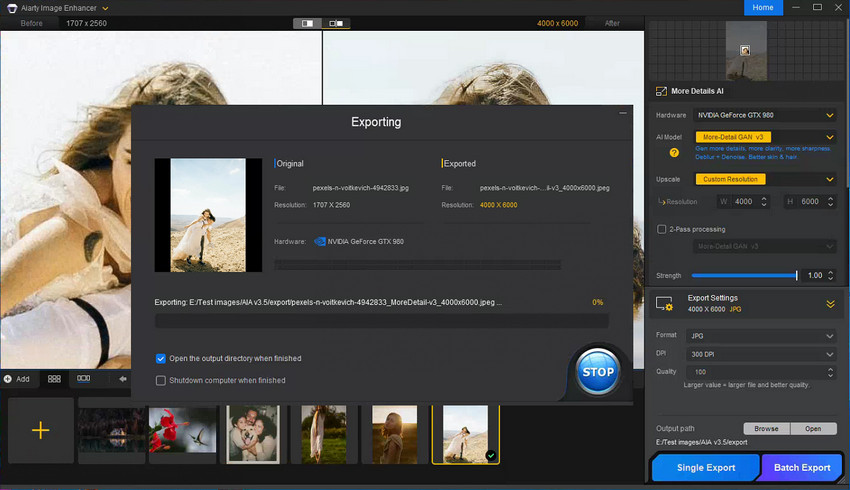Choosing the right picture frame size is one of the most important steps in creating a clean, balanced, and visually appealing wall display. Whether you're filling a blank wall, designing a gallery layout, or simply framing a favorite photo, knowing the differences between photo size, mat size, and frame size can save you a lot of guesswork.
This guide walks you through the most common picture frame sizes, how to pick the right size for your wall, and how to ensure your images are sharp enough for high-quality printing.
Before diving into frame sizes, it’s worth mentioning a key step many people overlook: image resolution. Larger frames require higher-resolution photos, especially if you want clean, sharp 300 DPI prints. Phone photos, older scans, or cropped images often don’t have enough pixels to support large prints like 16×20, 18×24, or 24×36 inches.
Aiarty Image Enhancer solves this problem by using AI super-resolution to increase image quality without losing detail. It can:
- Upscale images 2×, 4×, or 8×, 4K, 8K, 32K in 300 DPI.
- Restore clarity, texture, and fine details
- Repair compression artifacts from screenshots or old digital photos
- Generate more details in high-resolution that's suitable for professional printing
If you want your framed photos to look crisp up close, upscaling them before printing using Aiarty Image Enhancer makes a big difference.

Understanding Picture Frame Sizes: Photo Size vs Frame Size vs Mat Opening
Picture frame sizing is one of the most confusing parts of decorating a wall. A frame labeled 8×10 does not always display an 8×10 picture exactly as-is. This is because picture frames involve three related but different concepts: the photo size, the frame size, and the mat opening size. Knowing how these measurements work together will help you avoid ordering the wrong frames or ending up with a print that doesn’t fit.
- Photo Size: This is the dimension of the image itself (e.g., 5×7, 8×10, 11×14).
- Frame Size: This refers to the inner dimensions of the frame, not the outer border. A frame labeled 16×20 fits a 16×20 print or a smaller print with a mat.
- Mat Opening Size: If you’re using a mat, the opening is always slightly smaller than the photo to prevent slipping. For example, a 8×10 photo needs a 11×14 frame with a mat, and a 11×14 photo requires a 16×20 frame with a mat.

These three work together to determine how your final display looks, and mixing them up can lead to a frame that doesn’t fit, a mat that crops important details, or a layout that feels unbalanced. Once you understand how these measurements relate, choosing the right frame becomes much easier.
Related reading: How to Print 2x3 Wallet Size Photos from Your iPhone
Standard Picture Frame Sizes
Picture frames are generally grouped into small, medium, and large formats, each suited for different spaces and purposes. Understanding the typical uses for each category can help you choose frames that not only fit your photos but also complement your room’s layout and style.

Small Frame Sizes
- Common small frame dimensions include: 4×6, 5×7, 6×8
- These work well for desks, shelves, bedside tables, and small wall accents.
Medium Frame Sizes
- Popular mid-range frame dimensions include: 8×10, 11×14, 12×16
- These are ideal for hallways, bedrooms, and gallery wall clusters.
Large and Oversized Frame Sizes
- Common large frame dimensions include: 16×20, 18×24, 24×36
- These sizes are perfect for creating a focal point in living rooms, offices, or feature walls.
Larger frames demand high-resolution images to ensure crisp, clear prints. Photos that don’t meet 300 DPI requirements at these sizes may appear pixelated or blurry. This is where Aiarty Image Enhancer can help, by upscaling your images while maintaining sharpness and detail, making them ready for professional-quality large prints.
Using the right frame size ensures that your photos look proportionate and visually balanced, whether you’re filling a small wall or designing a striking, oversized display.
Wall Picture Frame Size Chart
Below is an easy-to-follow wall picture frame size chart covering photo size, frame size, mat options, and the best placement scenarios. You can use this chart when shopping for frames or planning a gallery wall layout.
How to Choose Frame Sizes for Your Wall
1. Measure Your Wall First
Before selecting a frame, take careful measurements of your wall space. A simple guideline is:
Ideal artwork width = wall width × 0.6
This ensures the piece will feel proportionate and balanced within the room. Keep in mind the surrounding furniture, trim, and other wall elements so the frame doesn’t overwhelm or feel too small for the space.
2. Decide Between a Single Large Frame or a Gallery Wall
Consider the impact you want to create. A single large frame works well as a focal point for a statement piece, while a gallery wall of smaller frames adds rhythm and visual interest. Mixing frame sizes, orientations, and mat colors can create depth, but keep spacing consistent for balance.

3. Portrait vs Landscape Orientation
Choose the frame orientation based on the shape and layout of your wall space. Portrait-oriented frames suit tall, narrow walls or spaces between furniture, while landscape-oriented frames work better on wide walls or above sofas and consoles. For gallery walls, mixing orientations can add dynamic interest, but always balance the overall composition so no single section feels overcrowded or lopsided.
Picture Frame Layout Tips
When arranging frames on your wall, there are some factors to consider:
- Hang at the Right Height (The Gallery Rule): Most professionals hang artwork so the center sits between 57–60 inches from the floor. This is roughly eye level.
- Spacing Between Frames: Consistent spacing makes the entire display look intentional and cohesive. Smaller frames typically need about 1–2 inches of space, while larger frames often look best with 2–4 inches between them.
- Choose Frames That Match Your Style: Wood, black metal, white frames, and vintage styles each create a different mood. Keep the overall decor theme in mind.
How to Print High-Quality Photos at 300 DPI for Any Picture Frame Size
300 DPI Print Guide: Minimum Resolutions for Each Frame Size
To achieve professional-quality prints, your image must meet the minimum pixel requirements for 300 DPI. This ensures the final print remains sharp, clear, and free from visible pixelation.
Learn more: How to Print iPhone Photos and How Big Can You Print?
Many smartphone photos, especially standard 12MP shots, don’t meet the required resolution for larger prints like 16×20 or 24×36, which can lead to soft or blurry results. If your image falls short of these pixel values, Aiarty Image Enhancer can upscale it to the necessary resolution while preserving detail and clarity, making it suitable for high-quality large-format printing.
How to Prepare Photos for Large Picture Frames Using Aiarty Image Enhancer
Before everything, look at your photo’s pixel dimensions to see whether it matches the 300 DPI requirement for your target print size. If not, go ahead to upscale picture resolution with Aiarty Image Enhancer.
Step 1. Load your pictures to Aiarty Image Enhancer.
Install and open up Aiarty Image Enhancer. Drag and drop to load your pictures into the program.

Step 2. Choose an AI model.
At the right panel, set your hardware to GPU if possible. Then choose an AI model that best fit with your picture, usually more-Deatil GAN v3 for generating more details, clarity and sharpness, AIGCsmooth v3 for AI arts and anime images, and Real-Photo for restoring photorealistic details.

Step 3. Set the upscale factor.
Choose the target resolution from the upscale dropdown menu according to your picture frame size. Aiarty allows you to enlarge image by 1x, 2x, 4x, 8x, directly in 2K, 4K, 8K, and customize to your frame size required resolution.

Step 4. Correct Color and Sharpness
Expand the Color panel, and tick on the Enable box. Then you are able to adjust exposure, contrast, white balance, and clarity before printing for a polished look.

Step 5. Export in Correct Format
For most prints, a high-quality JPEG is perfectly suitable and widely accepted. Expand the Export panel, and choose output format as JPEG, 300 DPI, 100 quality, and set the destination folder. When you're done, tap the Single Export to save the upscaled image individually or Batch Export to save multiple images at once.

Conclusion
Choosing the right frame size can completely transform how your photos look on the wall. With a clear understanding of picture frame sizes, wall layout strategies, and 300 DPI print requirements, you can confidently build a display that feels balanced and professional. And if your images lack resolution, Aiarty Image Enhancer makes it easy to upscale and enhance your photos for sharp, high-quality prints—no matter how large your frame is.
 FAQs
FAQs
The most commonly used frame sizes are 8×10, 11×14, and 16×20. These sizes fit well in living rooms, bedrooms, offices, and gallery wall layouts.
You can place an 8×10 photo in an 8×10 frame (no mat) for a clean fit, or choose an 11×14 frame with a mat if you prefer a more polished, gallery-style presentation.
Most modern smartphone photos (around 12MP) print well up to 11×14 or even 16×20. For anything larger, you may need to upscale your image to avoid visible softness or pixelation.
Check that your image meets the 300 DPI resolution requirements for the print size you want. If it falls short, you can use Aiarty Image Enhancer to upscale and improve clarity before printing.
Mats help draw attention to the photo, improve visual balance, and make smaller images fit larger frames. They’re especially useful for creating a clean, gallery-quality look on your wall.